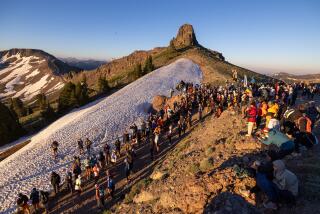It’s the hottest little ol’ bicycle race in Texas : Wichita Falls doesn’t believe in soft-pedaling its wild and windy image. Its annual promotional event is perhaps the world’s least comfortable contest.
- Share via
WICHITA FALLS, Tex. — Here near the Texas-Oklahoma border, a land of oil wells and pastureland where the wind never seems to stop, where the sun broils the blacktop and saps the strength, the cyclists come each year.
They come by the thousands to ride in what has become the largest 100-mile bicycle race in the world--the Hotter’N Hell Hundred. The name is apt, because the race takes place on the last Saturday before the Labor Day weekend, a time of year when temperatures regularly soar past 100 degrees and the winds can beat down even the best of riders.
And so they came again this year, almost 11,000 of them, an army in Lycra shorts and cycling jerseys, to this unlikeliest of destinations. They came from almost every state to have a shot at this ride, which is so physically demanding that more than 700 medical workers are kept on duty during the day. Hotels were booked for 50 miles around for the riders, who assembled before dawn at the city stadium. The mass of bikes was so large at the start that it took 30 miles before it thinned out.
The oddity of this ride is that, with each passing year, it has become more and more the symbol of Wichita Falls, a city of 100,000 people that could hardly be called a cycling bastion. The sight of a bicyclist in days past caused heads to turn in the pickup truck. Tornadoes were once more numerous than cyclists in Wichita Falls, which owes its existence to the fact that the railroad was enticed to divert its route slightly a century ago.
The tract of land that eventually became Wichita Falls was won in a poker game, and one of the first structures was the White Elephant Saloon.
At one time there were so many bars--one-fifth of all the businesses here--that the city was dubbed Whiskeytaw Falls.
More recently an Air Force base, cattle and oil have kept the city’s engine running. But in 1982, as Wichita Falls was about to turn 100, its fortunes started to fade. The oil and cattle businesses were weakening. A consultant suggested that something jazzy, such as a rocking chair race, might draw crowds and money to Wichita Falls.
The city fathers passed on the rocking chair idea and embraced instead postal worker Roby Christie’s suggestion of a 100-mile bike ride in 100-degree heat to celebrate Wichita Falls’ 100th anniversary. Hence the Hotter’N Hell Hundred.
Just 1,100 riders showed up for the first ride in 1982, but that was turnout enough to convince Wichita Falls boosters that they really had something in a bike ride held in heat that causes most people to retreat indoors.
“I don’t know if anyone remembers who won that first one,” said Mike Flavin, a race spokesman.
Today, the Hotter’N Hell Hundred commands the attention of virtually the entire city as race weekend approaches. And with good reason. Flavin said that cyclists and their families spend at least $1 million just for lodging and food. Hundreds of thousands of dollars more are spent buying cycling gear at the huge products display that is set up at the city activities center during the weekend.
“For something like this the whole town turns out,” Flavin said.
Logistics for this kind of event can be daunting, especially for a city the size of this one. This year, for example, more than 18,000 T-shirts were printed and the cyclists consumed more than 2,700 pounds of pasta at the pre-race dinner.
Motels that have been closed were opened for the occasion, and people with extra bedrooms were asked to take in the riders. Then there was the matter of stocking 36,000 bananas, 44,000 oranges, 75,000 cups and 70,000 pounds of ice.
This year’s ride proved to be kinder than past ones. Temperatures were hot but not sizzling. The wind was brisk but not daunting. Still, one man did die of a heart attack on the last leg of the race.
As always, the festive air of the morning turned grim in the afternoon as the mercury reached the 90s and the wind picked up. The fastest racer, John Frey, did the course in 3 1/2 hours, while others struggled to finish late in the afternoon.
Left along the route were hundreds of water bottles that had been jostled from their cages, along with pumps and spare tires. Cyclist Roland Lindsey said he couldn’t believe his ears when he heard riders ahead of him warning about an obstacle in the road.
“They were yelling ‘pedal!’ ” he said. “And sure enough, there was a pedal in the road, with no sign of the bike it belonged to.”
More to Read
Sign up for Essential California
The most important California stories and recommendations in your inbox every morning.
You may occasionally receive promotional content from the Los Angeles Times.













